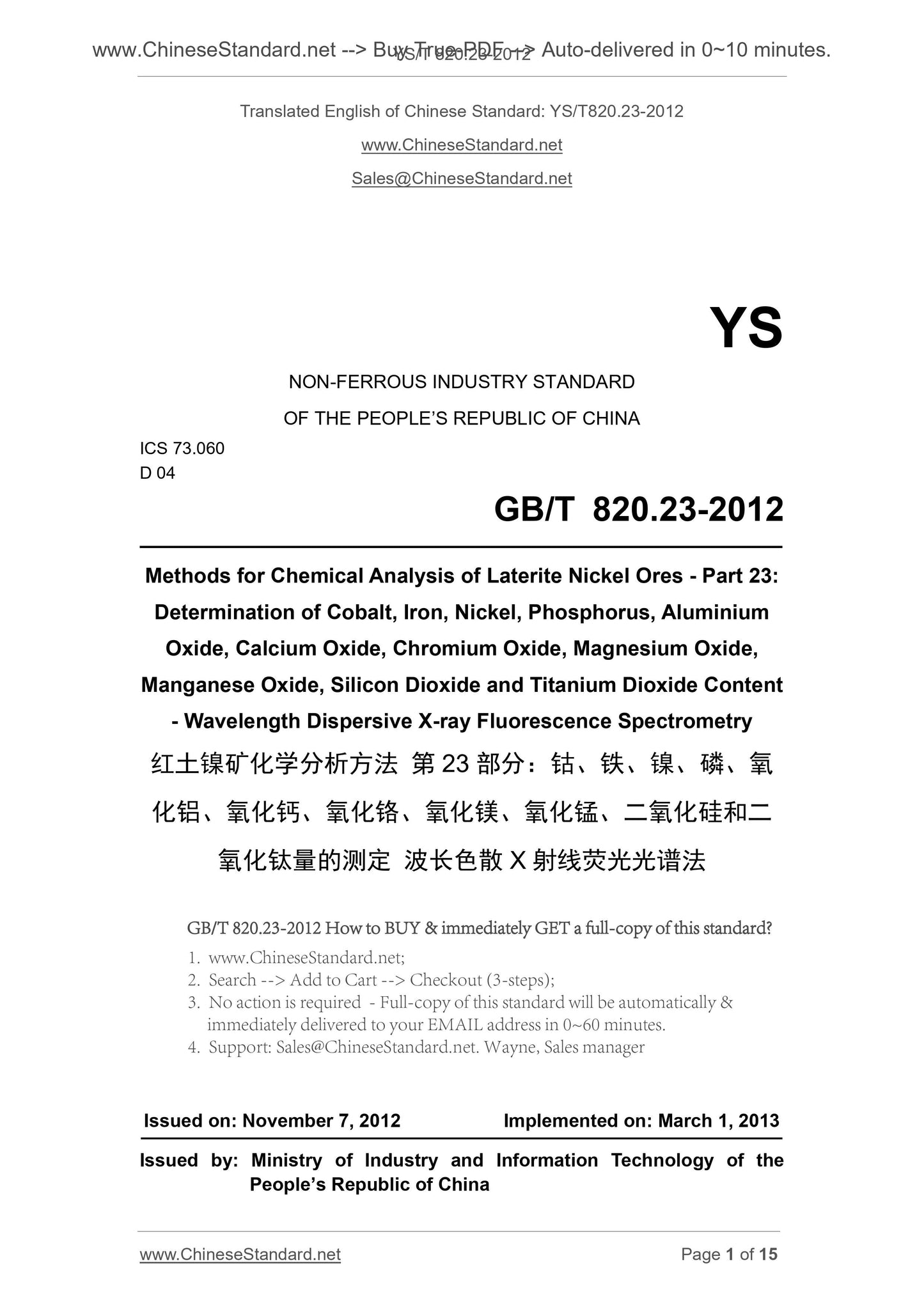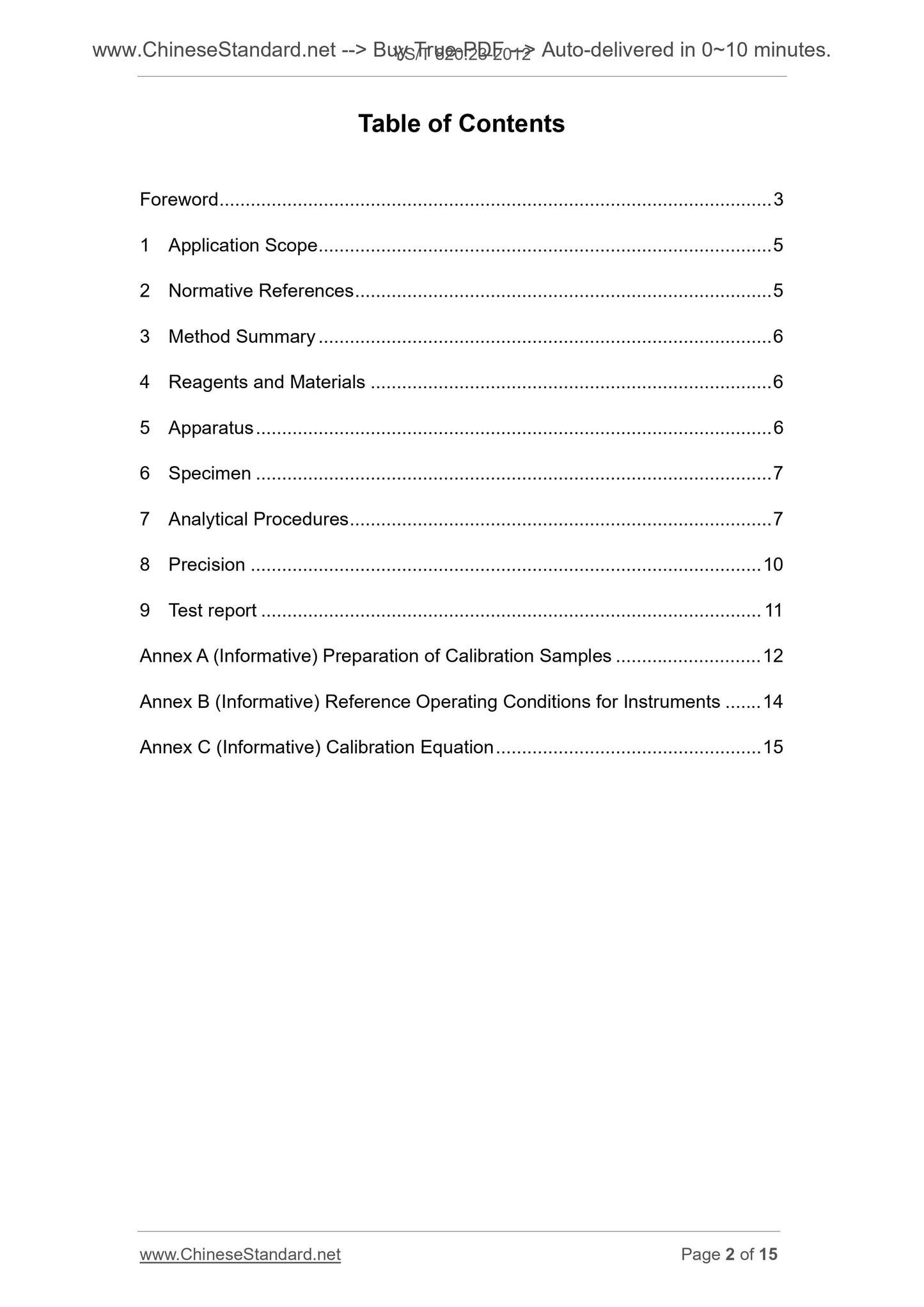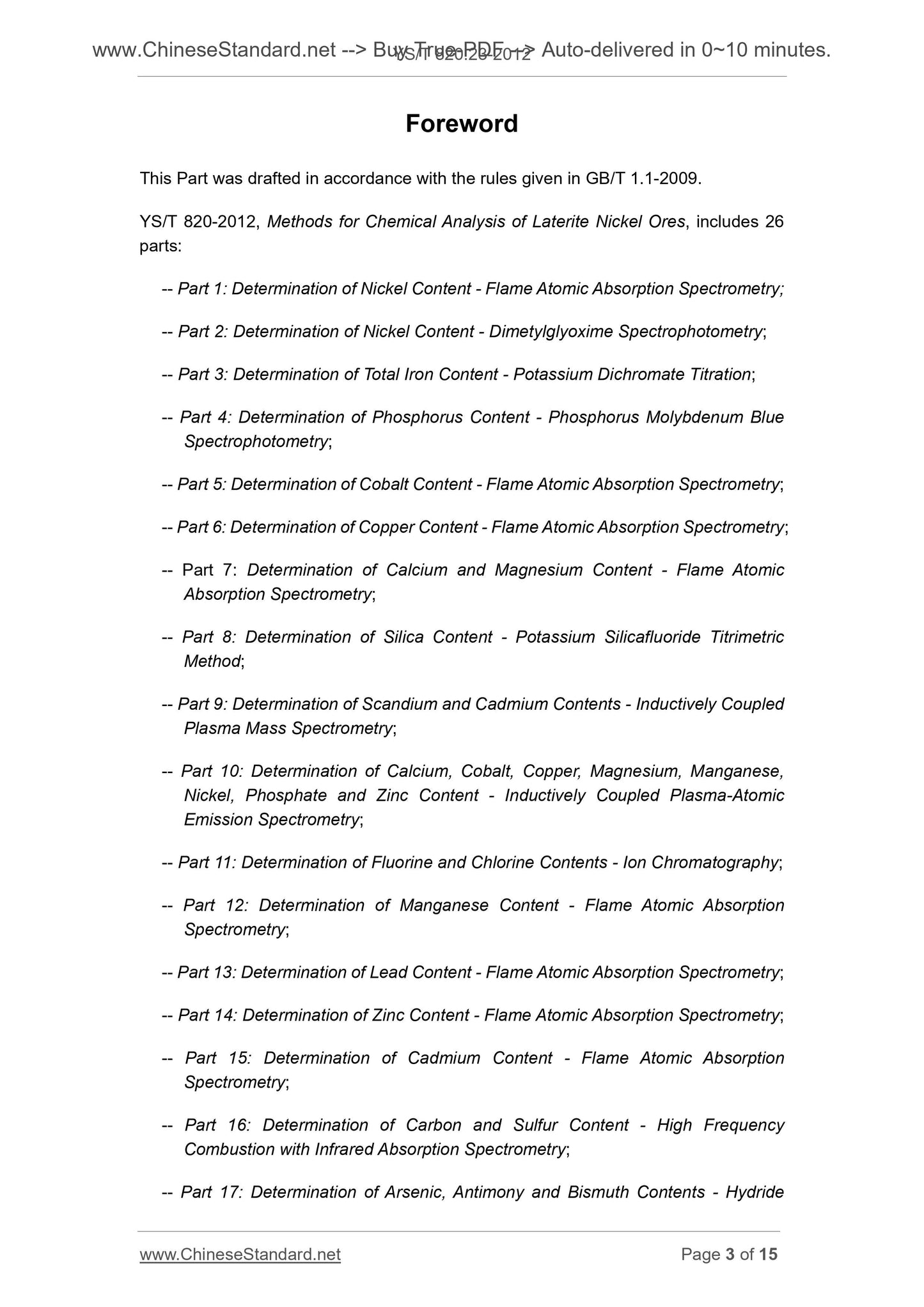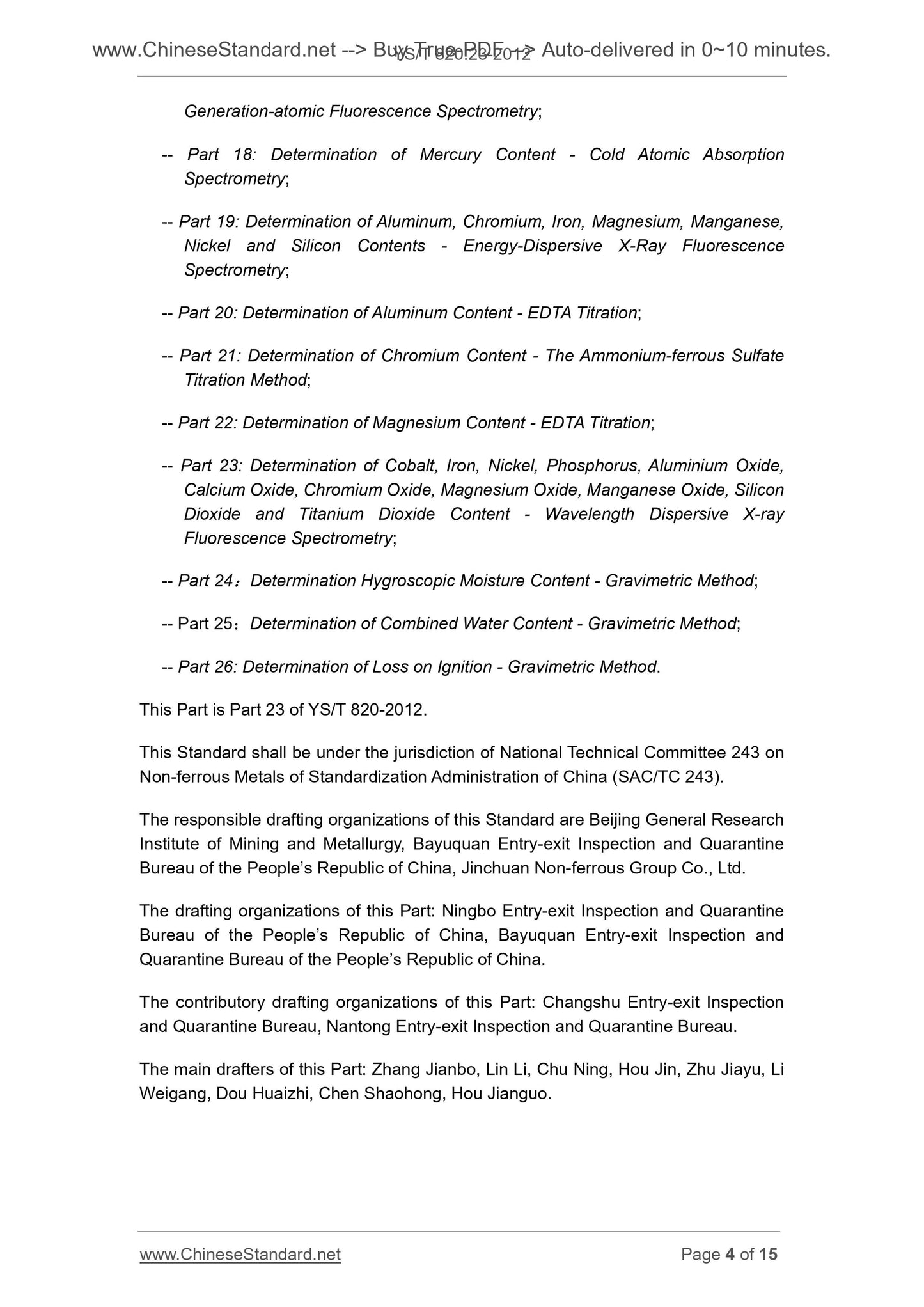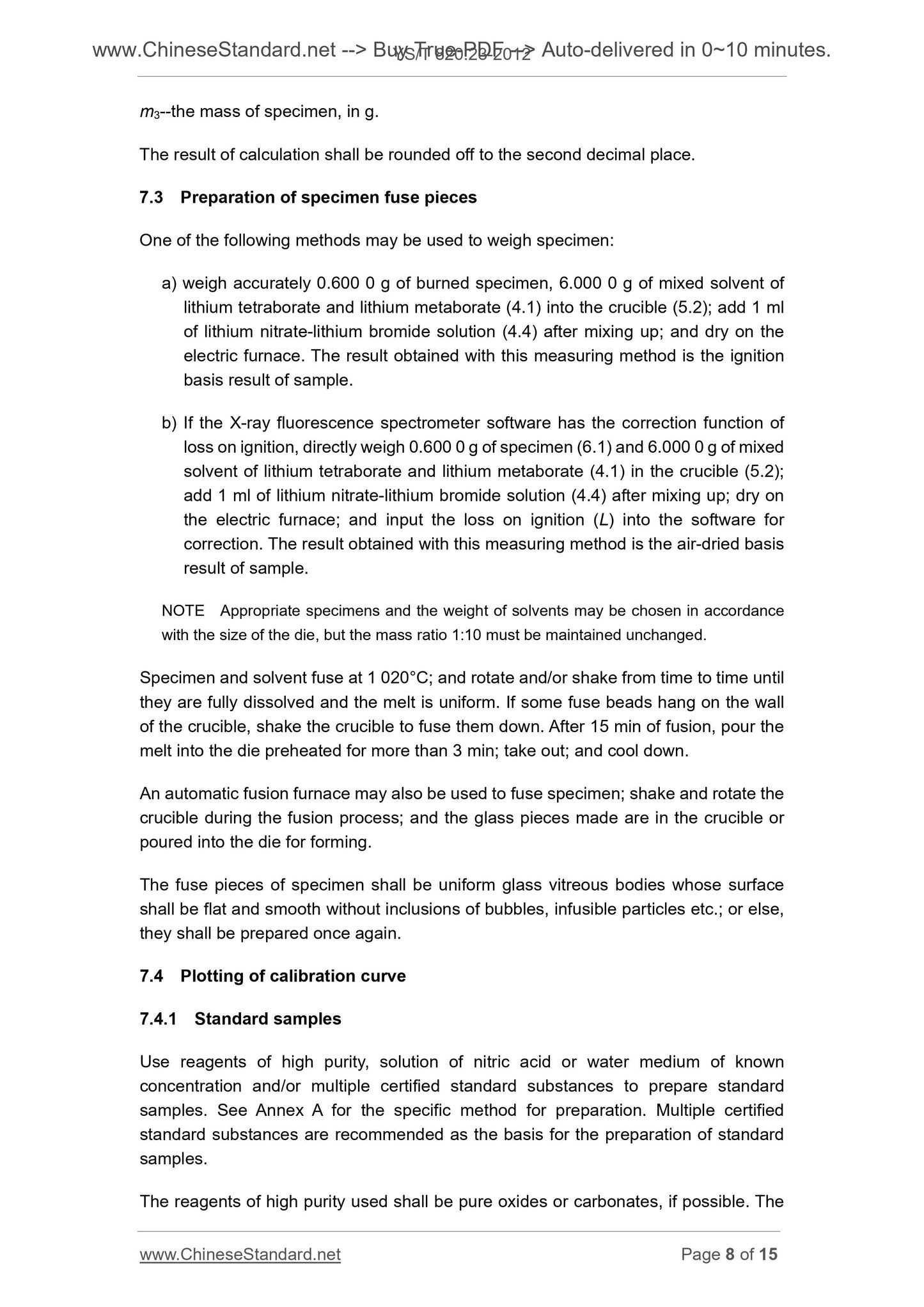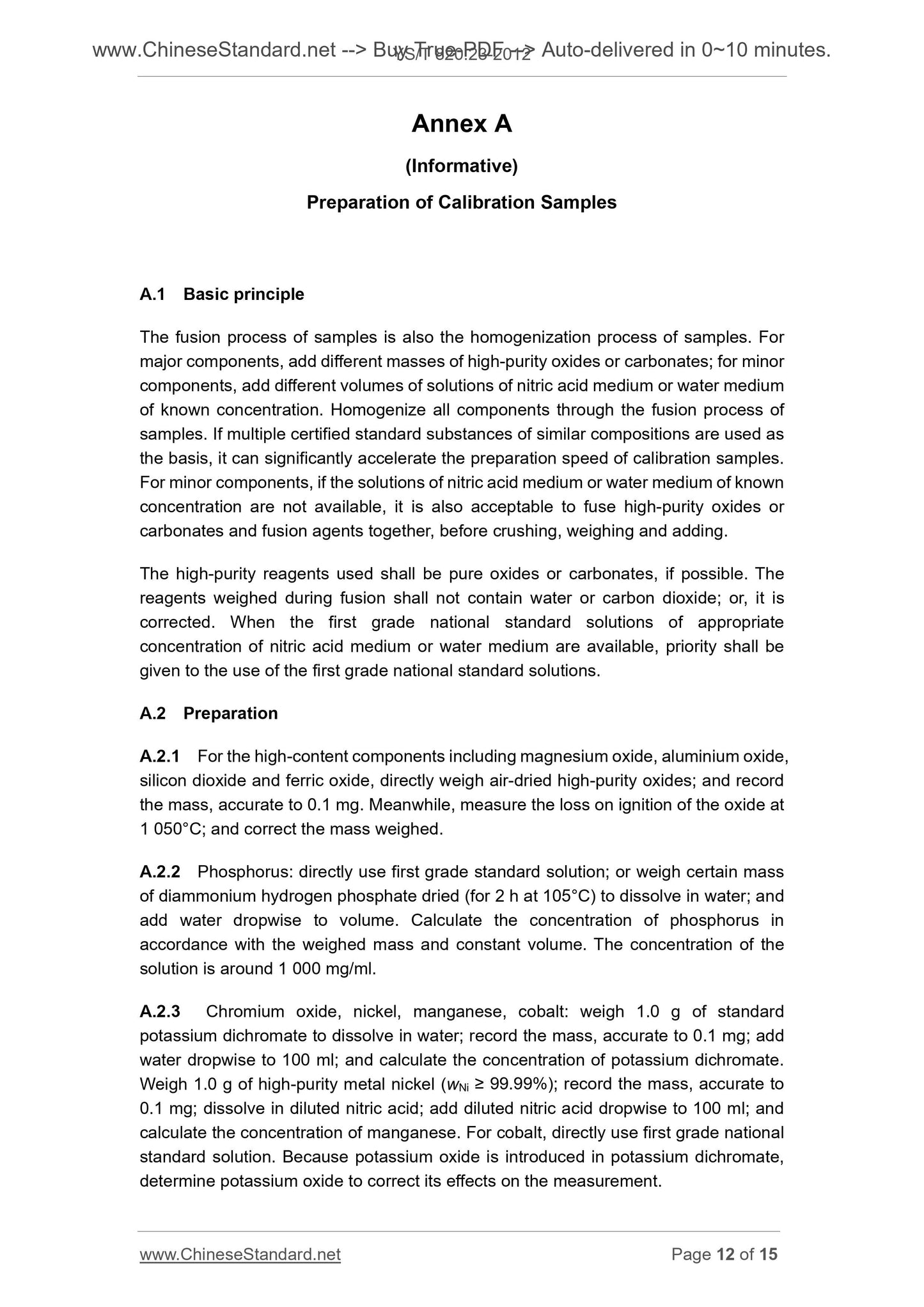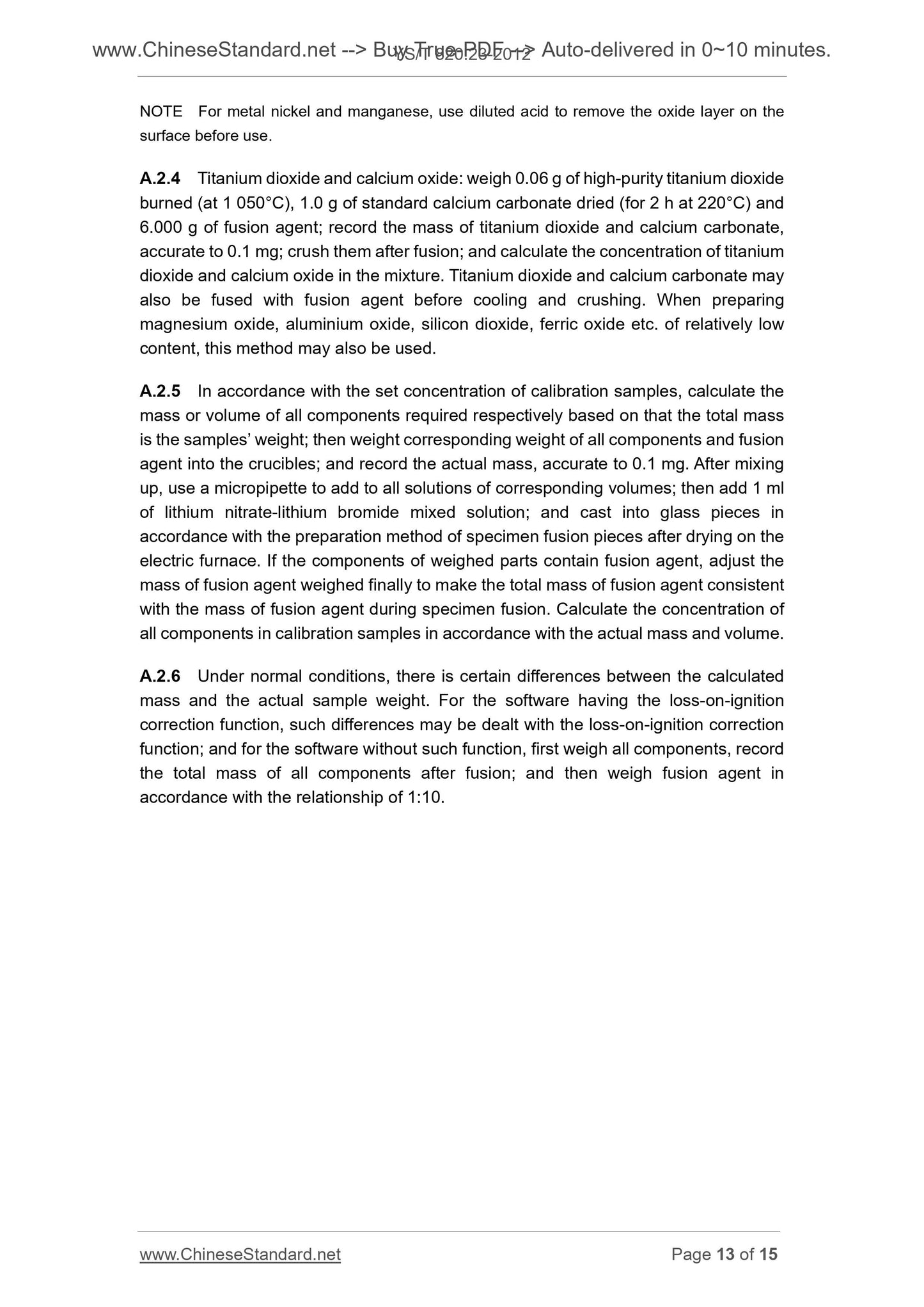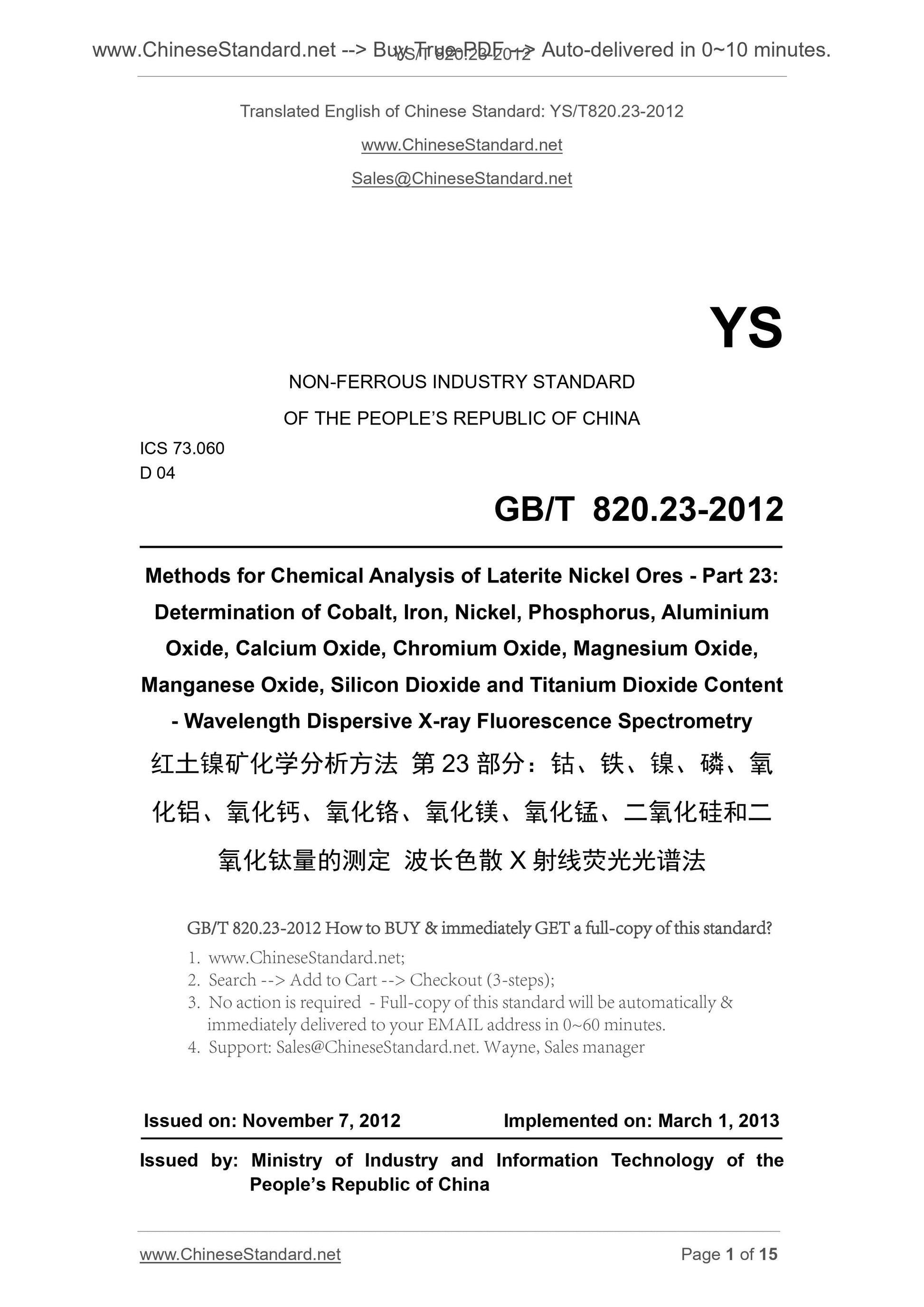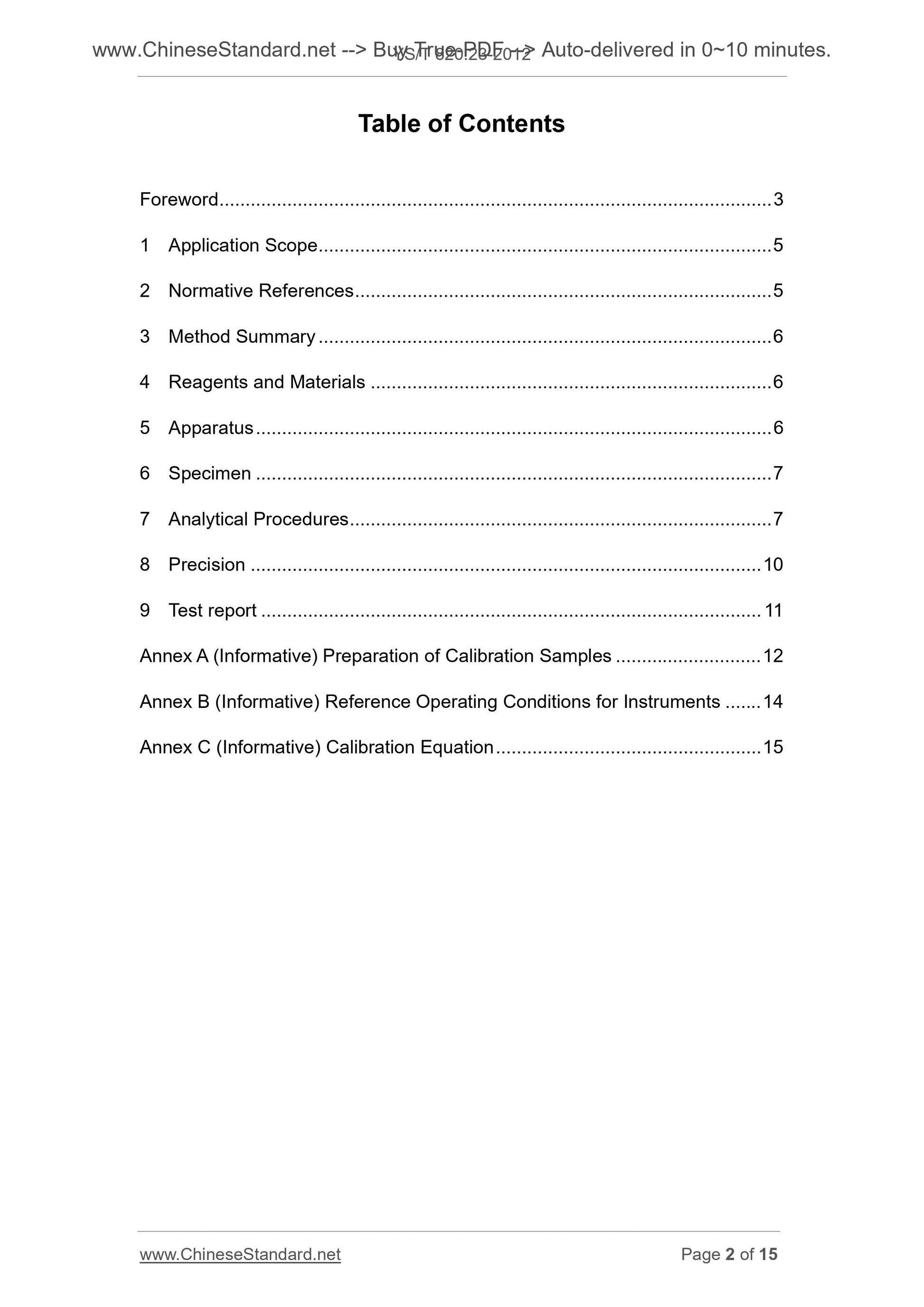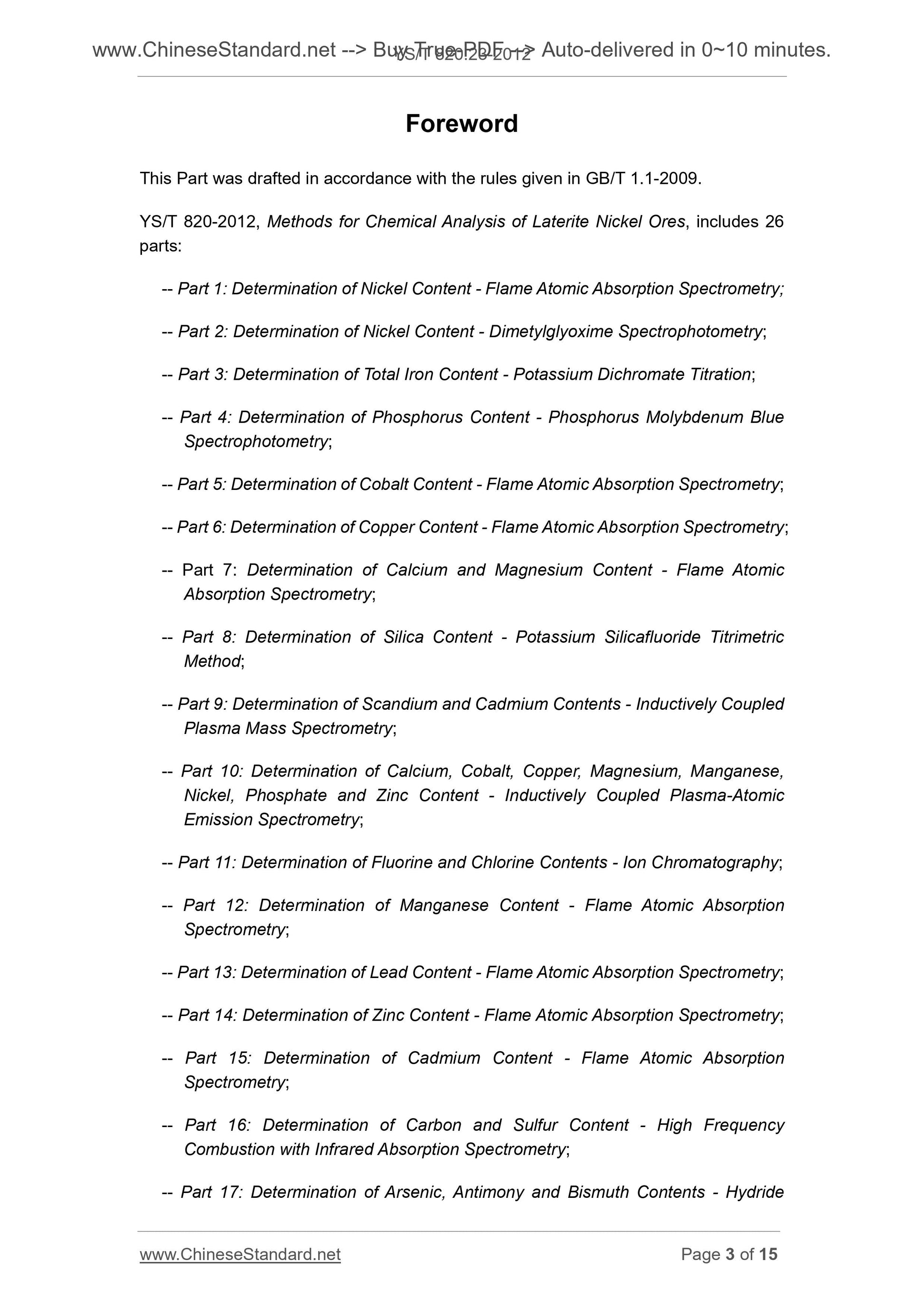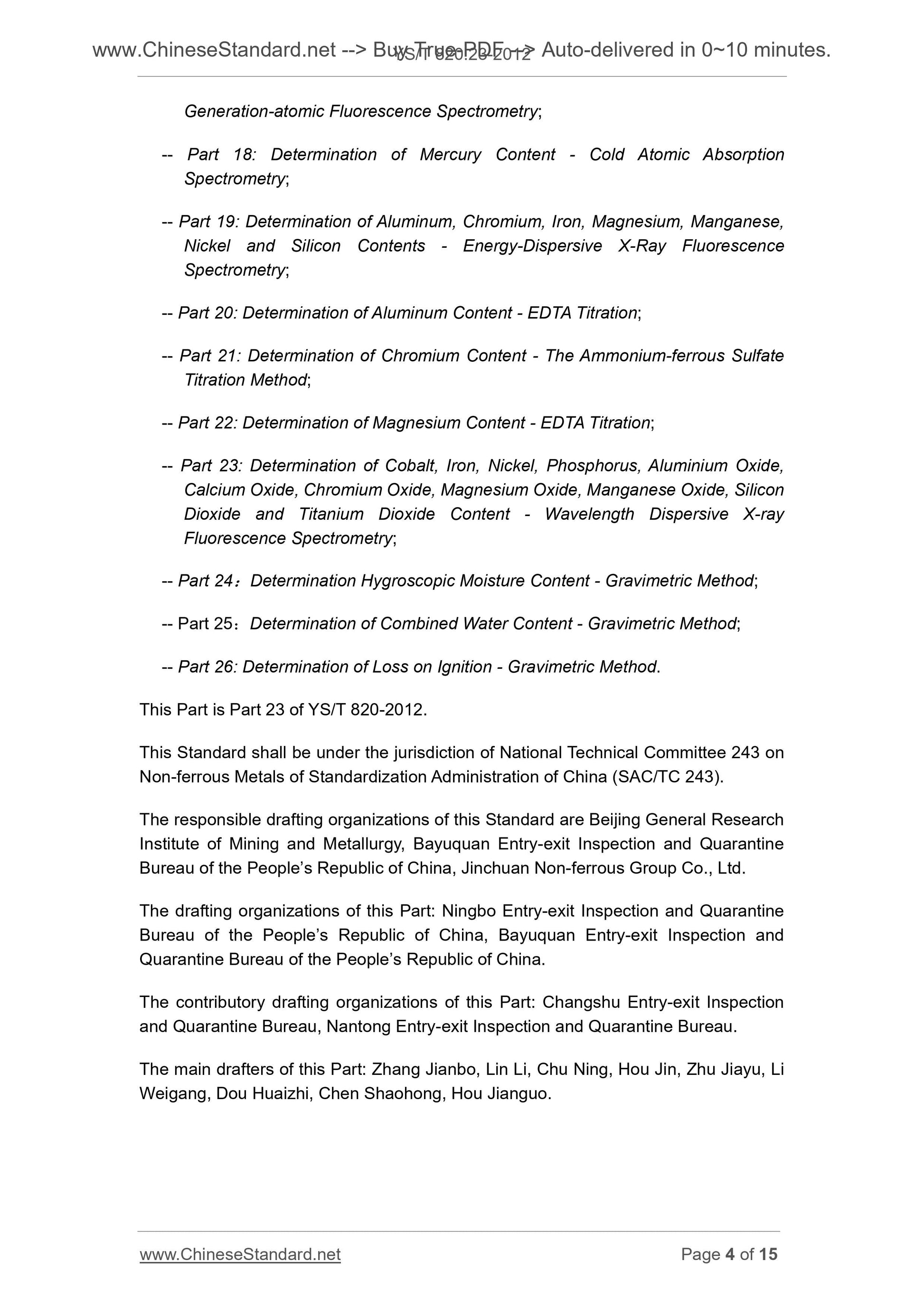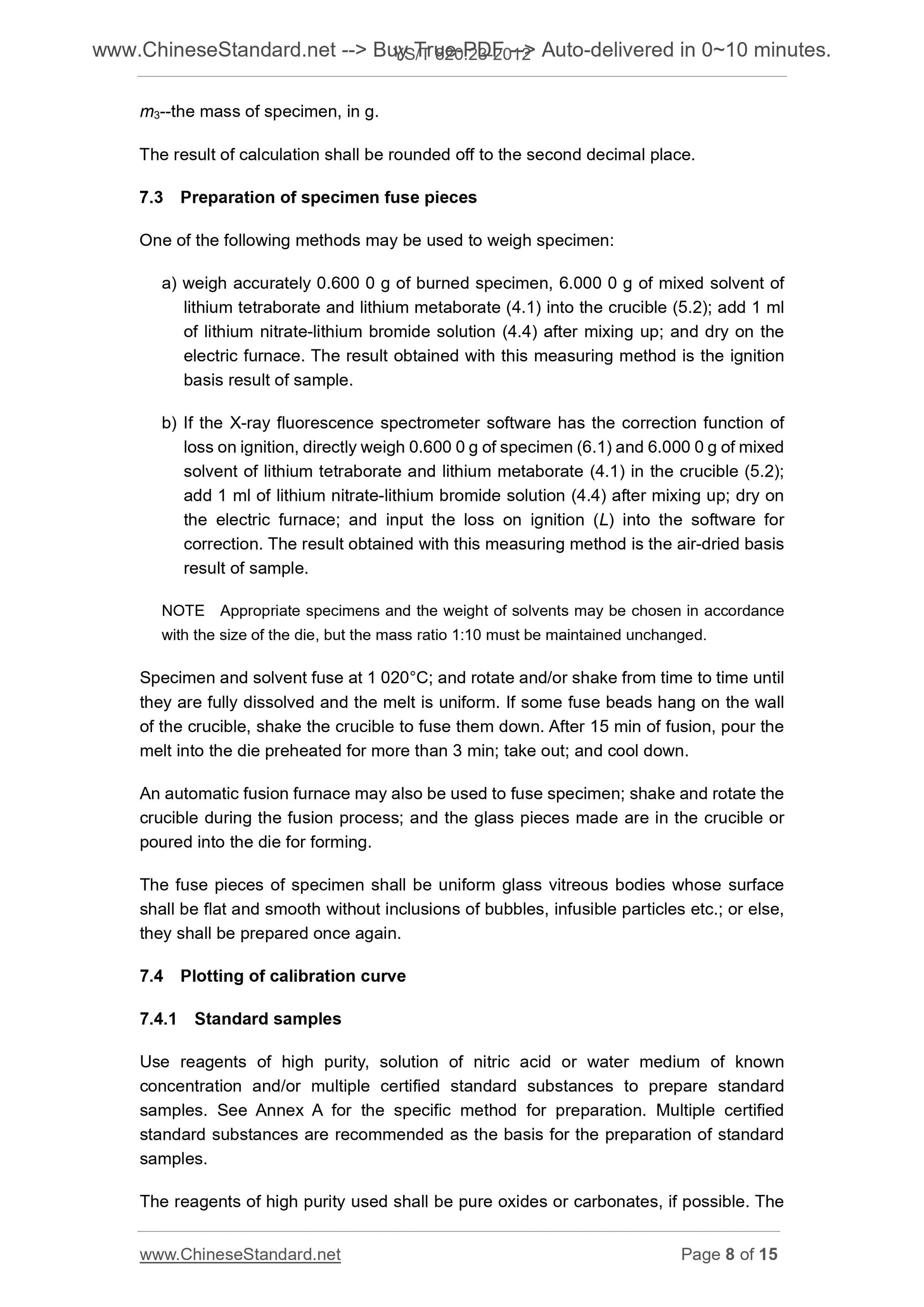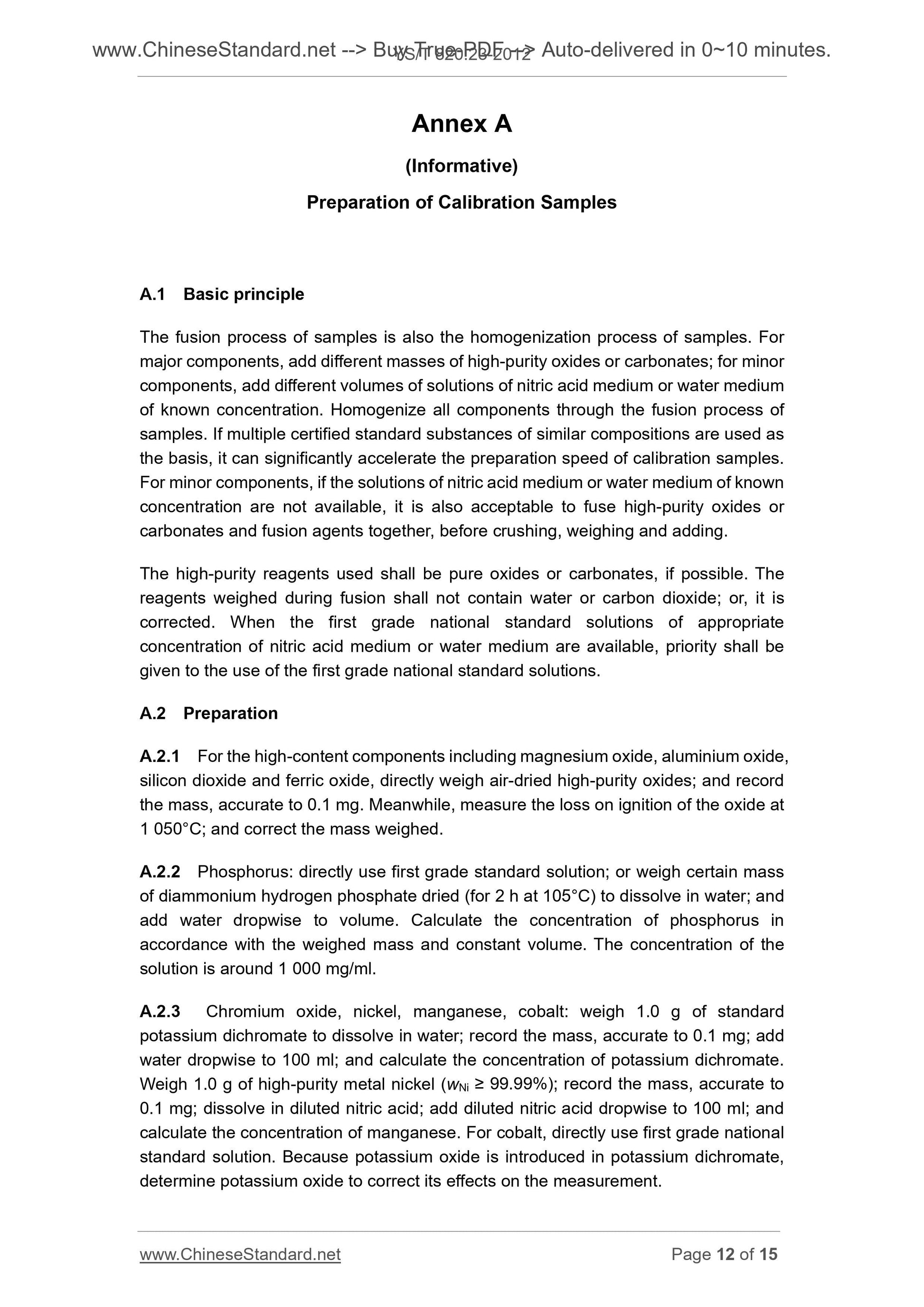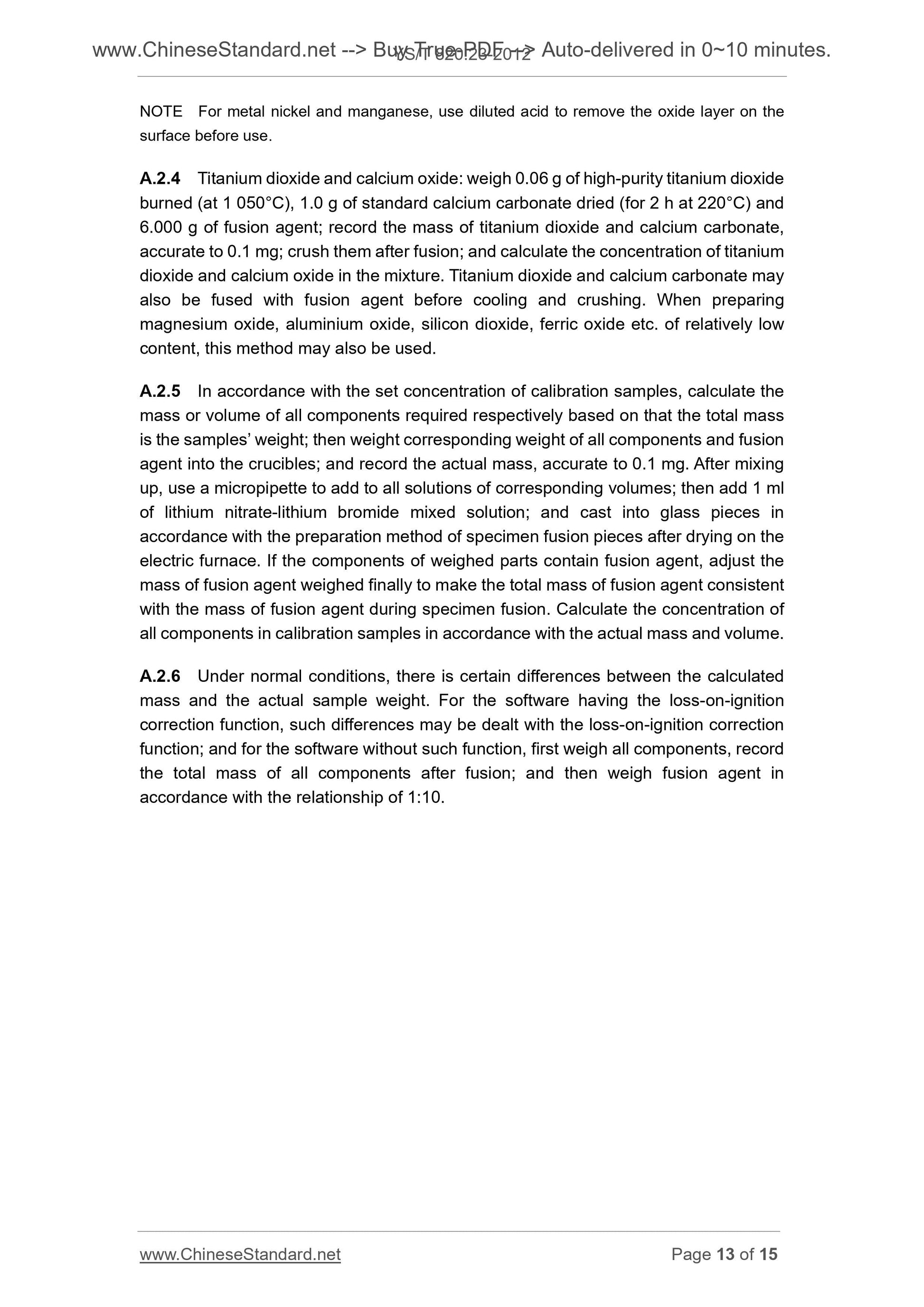1
/
of
7
PayPal, credit cards. Download editable-PDF and invoice in 1 second!
YS/T 820.23-2012 English PDF (YST820.23-2012)
YS/T 820.23-2012 English PDF (YST820.23-2012)
Regular price
$135.00 USD
Regular price
Sale price
$135.00 USD
Unit price
/
per
Shipping calculated at checkout.
Couldn't load pickup availability
Delivery: 3 seconds. Download true-PDF + Invoice.
Get QUOTATION in 1-minute: Click YS/T 820.23-2012
Historical versions: YS/T 820.23-2012
Preview True-PDF (Reload/Scroll if blank)
YS/T 820.23-2012: Methods for chemical analysis of laterite nickel ores. Part 23: Determnation of cobalt, iron, nickel, phosphorus, aluminium oxide, calcium oxide, chromium oxide, magnesium oxide, manganese oxide, silicon dioxide and titanium dioxide content. Wavelength di
YS/T 820.23-2012
YS
NON-FERROUS INDUSTRY STANDARD
OF THE PEOPLE’S REPUBLIC OF CHINA
ICS 73.060
D 04
GB/T 820.23-2012
Methods for Chemical Analysis of Laterite Nickel Ores - Part 23.
Determination of Cobalt, Iron, Nickel, Phosphorus, Aluminium
Oxide, Calcium Oxide, Chromium Oxide, Magnesium Oxide,
Manganese Oxide, Silicon Dioxide and Titanium Dioxide Content
- Wavelength Dispersive X-ray Fluorescence Spectrometry
ISSUED ON. NOVEMBER 7, 2012
IMPLEMENTED ON. MARCH 1, 2013
Issued by. Ministry of Industry and Information Technology of the
People’s Republic of China
3. No action is required - Full-copy of this standard will be automatically and
immediately delivered to your EMAIL address in 0~60 minutes.
Table of Contents
Foreword ... 3
1 Application Scope ... 5
2 Normative References ... 5
3 Method Summary ... 6
4 Reagents and Materials ... 6
5 Apparatus ... 6
6 Specimen ... 7
7 Analytical Procedures ... 7
8 Precision ... 10
9 Test report ... 11
Annex A (Informative) Preparation of Calibration Samples ... 12
Annex B (Informative) Reference Operating Conditions for Instruments ... 14
Annex C (Informative) Calibration Equation ... 15
Foreword
This Part was drafted in accordance with the rules given in GB/T 1.1-2009.
YS/T 820-2012, Methods for Chemical Analysis of Laterite Nickel Ores, includes 26
parts.
-- Part 1. Determination of Nickel Content - Flame Atomic Absorption Spectrometry;
-- Part 2. Determination of Nickel Content - Dimetylglyoxime Spectrophotometry;
-- Part 3. Determination of Total Iron Content - Potassium Dichromate Titration;
-- Part 4. Determination of Phosphorus Content - Phosphorus Molybdenum Blue
Spectrophotometry;
-- Part 5. Determination of Cobalt Content - Flame Atomic Absorption Spectrometry;
-- Part 6. Determination of Copper Content - Flame Atomic Absorption Spectrometry;
-- Part 7. Determination of Calcium and Magnesium Content - Flame Atomic
Absorption Spectrometry;
-- Part 8. Determination of Silica Content - Potassium Silicafluoride Titrimetric
Method;
-- Part 9. Determination of Scandium and Cadmium Contents - Inductively Coupled
Plasma Mass Spectrometry;
-- Part 10. Determination of Calcium, Cobalt, Copper, Magnesium, Manganese,
Nickel, Phosphate and Zinc Content - Inductively Coupled Plasma-Atomic
Emission Spectrometry;
-- Part 11. Determination of Fluorine and Chlorine Contents - Ion Chromatography;
-- Part 12. Determination of Manganese Content - Flame Atomic Absorption
Spectrometry;
-- Part 13. Determination of Lead Content - Flame Atomic Absorption Spectrometry;
-- Part 14. Determination of Zinc Content - Flame Atomic Absorption Spectrometry;
-- Part 15. Determination of Cadmium Content - Flame Atomic Absorption
Spectrometry;
-- Part 16. Determination of Carbon and Sulfur Content - High Frequency
Combustion with Infrared Absorption Spectrometry;
-- Part 17. Determination of Arsenic, Antimony and Bismuth Contents - Hydride
Generation-atomic Fluorescence Spectrometry;
-- Part 18. Determination of Mercury Content - Cold Atomic Absorption
Spectrometry;
-- Part 19. Determination of Aluminum, Chromium, Iron, Magnesium, Manganese,
Nickel and Silicon Contents - Energy-Dispersive X-Ray Fluorescence
Spectrometry;
-- Part 20. Determination of Aluminum Content - EDTA Titration;
-- Part 21. Determination of Chromium Content - The Ammonium-ferrous Sulfate
Titration Method;
-- Part 22. Determination of Magnesium Content - EDTA Titration;
-- Part 23. Determination of Cobalt, Iron, Nickel, Phosphorus, Aluminium Oxide,
Calcium Oxide, Chromium Oxide, Magnesium Oxide, Manganese Oxide, Silicon
Dioxide and Titanium Dioxide Content - Wavelength Dispersive X-ray
Fluorescence Spectrometry;
-- Part 24. Determination Hygroscopic Moisture Content - Gravimetric Method;
-- Part 25. Determination of Combined Water Content - Gravimetric Method;
-- Part 26. Determination of Loss on Ignition - Gravimetric Method.
This Part is Part 23 of YS/T 820-2012.
This Standard shall be under the jurisdiction of National Technical Committee 243 on
Non-ferrous Metals of Standardization Administration of China (SAC/TC 243).
The responsible drafting organizations of this Standard are Beijing General Research
Institute of Mining and Metallurgy, Bayuquan Entry-exit Inspection and Quarantine
Bureau of the People’s Republic of China, Jinchuan Non-ferrous Group Co., Ltd.
The drafting organizations of this Part. Ningbo Entry-exit Inspection and Quarantine
Bureau of the People’s Republic of China, Bayuquan Entry-exit Inspection and
Quarantine Bureau of the People’s Republic of China.
The contributory drafting organizations of this Part. Changshu Entry-exit Inspection
and Quarantine Bureau, Nantong Entry-exit Inspection and Quarantine Bureau.
The main drafters of this Part. Zhang Jianbo, Lin Li, Chu Ning, Hou Jin, Zhu Jiayu, Li
Weigang, Dou Huaizhi, Chen Shaohong, Hou Jianguo.
m3--the mass of specimen, in g.
The result of calculation shall be rounded off to the second decimal place.
7.3 Preparation of specimen fuse pieces
One of the following methods may be used to weigh specimen.
a) weigh accurately 0.600 0 g of burned specimen, 6.000 0 g of mixed solvent of
lithium tetraborate and lithium metaborate (4.1) into the crucible (5.2); add 1 ml
of lithium nitrate-lithium bromide solution (4.4) after mixing up; and dry on the
electric furnace. The result obtained with this measuring method is the ignition
basis result of sample.
b) If the X-ray fluorescence spectrometer software has the correction function of
loss on ignition, directly weigh 0.600 0 g of specimen (6.1) and 6.000 0 g of mixed
solvent of lithium tetraborate and lithium metaborate (4.1) in the crucible (5.2);
add 1 ml of lithium nitrate-lithium bromide solution (4.4) after mixing up; dry on
the electric furnace; and input the loss on ignition (L) into the software for
correction. The result obtained with this measuring method is the air-dried basis
result of sample.
NOTE Appropriate specimens and the weight of solvents may be chosen in accordance
with the size of the die, but the mass ratio 1.10 must be maintained unchanged.
Specimen and solvent fuse at 1 020°C; and rotate and/or shake from time to time until
they are fully dissolved and the melt is uniform. If some fuse beads hang on the wall
of the crucible, shake the crucible to fuse them down. After 15 min of fusion, pour the
melt into the die preheated for more than 3 min; take out; and cool down.
An automatic fusion furnace may also be used to fuse specimen; shake and rotate the
crucible during the fusion process; and the glass pieces made are in the crucible or
poured into the die for forming.
The fuse pieces of specimen shall be uniform glass vitreous bodies whose surface
shall be flat and smooth without inclusions of bubbles, infusible particles etc.; or else,
they shall be prepared once again.
7.4 Plotting of calibration curve
7.4.1 Standard samples
Use reagents of high purity, solution of nitric acid or water medium of known
concentration and/or multiple certified standard substances to prepare standard
samples. See Annex A for the specific method for preparation. Multiple certified
standard substances are recommended as the basis for the preparation of standard
samples.
The reagents of high purity used shall be pure oxides or carbonates, if possible. The
Annex A
(Informative)
Preparation of Calibration Sam...
Get QUOTATION in 1-minute: Click YS/T 820.23-2012
Historical versions: YS/T 820.23-2012
Preview True-PDF (Reload/Scroll if blank)
YS/T 820.23-2012: Methods for chemical analysis of laterite nickel ores. Part 23: Determnation of cobalt, iron, nickel, phosphorus, aluminium oxide, calcium oxide, chromium oxide, magnesium oxide, manganese oxide, silicon dioxide and titanium dioxide content. Wavelength di
YS/T 820.23-2012
YS
NON-FERROUS INDUSTRY STANDARD
OF THE PEOPLE’S REPUBLIC OF CHINA
ICS 73.060
D 04
GB/T 820.23-2012
Methods for Chemical Analysis of Laterite Nickel Ores - Part 23.
Determination of Cobalt, Iron, Nickel, Phosphorus, Aluminium
Oxide, Calcium Oxide, Chromium Oxide, Magnesium Oxide,
Manganese Oxide, Silicon Dioxide and Titanium Dioxide Content
- Wavelength Dispersive X-ray Fluorescence Spectrometry
ISSUED ON. NOVEMBER 7, 2012
IMPLEMENTED ON. MARCH 1, 2013
Issued by. Ministry of Industry and Information Technology of the
People’s Republic of China
3. No action is required - Full-copy of this standard will be automatically and
immediately delivered to your EMAIL address in 0~60 minutes.
Table of Contents
Foreword ... 3
1 Application Scope ... 5
2 Normative References ... 5
3 Method Summary ... 6
4 Reagents and Materials ... 6
5 Apparatus ... 6
6 Specimen ... 7
7 Analytical Procedures ... 7
8 Precision ... 10
9 Test report ... 11
Annex A (Informative) Preparation of Calibration Samples ... 12
Annex B (Informative) Reference Operating Conditions for Instruments ... 14
Annex C (Informative) Calibration Equation ... 15
Foreword
This Part was drafted in accordance with the rules given in GB/T 1.1-2009.
YS/T 820-2012, Methods for Chemical Analysis of Laterite Nickel Ores, includes 26
parts.
-- Part 1. Determination of Nickel Content - Flame Atomic Absorption Spectrometry;
-- Part 2. Determination of Nickel Content - Dimetylglyoxime Spectrophotometry;
-- Part 3. Determination of Total Iron Content - Potassium Dichromate Titration;
-- Part 4. Determination of Phosphorus Content - Phosphorus Molybdenum Blue
Spectrophotometry;
-- Part 5. Determination of Cobalt Content - Flame Atomic Absorption Spectrometry;
-- Part 6. Determination of Copper Content - Flame Atomic Absorption Spectrometry;
-- Part 7. Determination of Calcium and Magnesium Content - Flame Atomic
Absorption Spectrometry;
-- Part 8. Determination of Silica Content - Potassium Silicafluoride Titrimetric
Method;
-- Part 9. Determination of Scandium and Cadmium Contents - Inductively Coupled
Plasma Mass Spectrometry;
-- Part 10. Determination of Calcium, Cobalt, Copper, Magnesium, Manganese,
Nickel, Phosphate and Zinc Content - Inductively Coupled Plasma-Atomic
Emission Spectrometry;
-- Part 11. Determination of Fluorine and Chlorine Contents - Ion Chromatography;
-- Part 12. Determination of Manganese Content - Flame Atomic Absorption
Spectrometry;
-- Part 13. Determination of Lead Content - Flame Atomic Absorption Spectrometry;
-- Part 14. Determination of Zinc Content - Flame Atomic Absorption Spectrometry;
-- Part 15. Determination of Cadmium Content - Flame Atomic Absorption
Spectrometry;
-- Part 16. Determination of Carbon and Sulfur Content - High Frequency
Combustion with Infrared Absorption Spectrometry;
-- Part 17. Determination of Arsenic, Antimony and Bismuth Contents - Hydride
Generation-atomic Fluorescence Spectrometry;
-- Part 18. Determination of Mercury Content - Cold Atomic Absorption
Spectrometry;
-- Part 19. Determination of Aluminum, Chromium, Iron, Magnesium, Manganese,
Nickel and Silicon Contents - Energy-Dispersive X-Ray Fluorescence
Spectrometry;
-- Part 20. Determination of Aluminum Content - EDTA Titration;
-- Part 21. Determination of Chromium Content - The Ammonium-ferrous Sulfate
Titration Method;
-- Part 22. Determination of Magnesium Content - EDTA Titration;
-- Part 23. Determination of Cobalt, Iron, Nickel, Phosphorus, Aluminium Oxide,
Calcium Oxide, Chromium Oxide, Magnesium Oxide, Manganese Oxide, Silicon
Dioxide and Titanium Dioxide Content - Wavelength Dispersive X-ray
Fluorescence Spectrometry;
-- Part 24. Determination Hygroscopic Moisture Content - Gravimetric Method;
-- Part 25. Determination of Combined Water Content - Gravimetric Method;
-- Part 26. Determination of Loss on Ignition - Gravimetric Method.
This Part is Part 23 of YS/T 820-2012.
This Standard shall be under the jurisdiction of National Technical Committee 243 on
Non-ferrous Metals of Standardization Administration of China (SAC/TC 243).
The responsible drafting organizations of this Standard are Beijing General Research
Institute of Mining and Metallurgy, Bayuquan Entry-exit Inspection and Quarantine
Bureau of the People’s Republic of China, Jinchuan Non-ferrous Group Co., Ltd.
The drafting organizations of this Part. Ningbo Entry-exit Inspection and Quarantine
Bureau of the People’s Republic of China, Bayuquan Entry-exit Inspection and
Quarantine Bureau of the People’s Republic of China.
The contributory drafting organizations of this Part. Changshu Entry-exit Inspection
and Quarantine Bureau, Nantong Entry-exit Inspection and Quarantine Bureau.
The main drafters of this Part. Zhang Jianbo, Lin Li, Chu Ning, Hou Jin, Zhu Jiayu, Li
Weigang, Dou Huaizhi, Chen Shaohong, Hou Jianguo.
m3--the mass of specimen, in g.
The result of calculation shall be rounded off to the second decimal place.
7.3 Preparation of specimen fuse pieces
One of the following methods may be used to weigh specimen.
a) weigh accurately 0.600 0 g of burned specimen, 6.000 0 g of mixed solvent of
lithium tetraborate and lithium metaborate (4.1) into the crucible (5.2); add 1 ml
of lithium nitrate-lithium bromide solution (4.4) after mixing up; and dry on the
electric furnace. The result obtained with this measuring method is the ignition
basis result of sample.
b) If the X-ray fluorescence spectrometer software has the correction function of
loss on ignition, directly weigh 0.600 0 g of specimen (6.1) and 6.000 0 g of mixed
solvent of lithium tetraborate and lithium metaborate (4.1) in the crucible (5.2);
add 1 ml of lithium nitrate-lithium bromide solution (4.4) after mixing up; dry on
the electric furnace; and input the loss on ignition (L) into the software for
correction. The result obtained with this measuring method is the air-dried basis
result of sample.
NOTE Appropriate specimens and the weight of solvents may be chosen in accordance
with the size of the die, but the mass ratio 1.10 must be maintained unchanged.
Specimen and solvent fuse at 1 020°C; and rotate and/or shake from time to time until
they are fully dissolved and the melt is uniform. If some fuse beads hang on the wall
of the crucible, shake the crucible to fuse them down. After 15 min of fusion, pour the
melt into the die preheated for more than 3 min; take out; and cool down.
An automatic fusion furnace may also be used to fuse specimen; shake and rotate the
crucible during the fusion process; and the glass pieces made are in the crucible or
poured into the die for forming.
The fuse pieces of specimen shall be uniform glass vitreous bodies whose surface
shall be flat and smooth without inclusions of bubbles, infusible particles etc.; or else,
they shall be prepared once again.
7.4 Plotting of calibration curve
7.4.1 Standard samples
Use reagents of high purity, solution of nitric acid or water medium of known
concentration and/or multiple certified standard substances to prepare standard
samples. See Annex A for the specific method for preparation. Multiple certified
standard substances are recommended as the basis for the preparation of standard
samples.
The reagents of high purity used shall be pure oxides or carbonates, if possible. The
Annex A
(Informative)
Preparation of Calibration Sam...
Share
